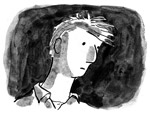Though this interview was conducted by email, Peter Blegvad and I met briefly a few months later in New York, when he participated in a conference on “The Word-Image Problem” at The New School, organized by Ben Katchor to celebrate the work of Swiss cartoon-strip pioneer Rodolphe Töpffer. In a lecture hall that may have been the least rock-friendly venue imaginable, Blegvad sang solo electric versions of “God Detector” (from 2001’s Choices Under Pressure) and “Bee Dream” (first heard on John Greaves’s 1984 album Parrot Fashions), accompanied by a PowerPoint show of his own charming, cryptic illustrations. It was the first time I had seen him perform since the mid-1980s, when he toured Southern California with Anton Fier’s group the Golden Palominos.
These appearances give some measure of the varied company Blegvad keeps, and of the difficulty of placing his artistic output on a high-low continuum. The scope of his visual and graphic work makes “cartoonist” a misleading label. An online search for his essay “On Numinous Objects and their Manufacture,” with its accompanying “Morphological Tables,” may explain why. Still, he may be best known for Leviathan, an allusive, frightening, and funny take on the “imaginative child” trope of comic strips from Peanuts to Calvin and Hobbes. The strip ran weekly from 1992 through 1999 in the London Independent on Sunday; a selection published by Sort Of Books was reissued by Overlook Press in the US last year.
Similarly, “singer-songwriter” fails to capture the range of a musician whose associates have included Slapp Happy cofounders Dagmar Krause and Anthony Moore, Marxist prog-rockers Henry Cow, and John Zorn, as well as the dB’s Chris Stamey and XTC’s Andy Partridge. Kew. Rhone. (1977), credited to Blegvad, Greaves, and singer Lisa Herman, takes an Oulipian approach to what might be called “The Word-Music Problem,” while such solo albums as The Naked Shakespeare (1983), King Strut (1990), and Hangman’s Hill (1998) raise the bar for “literate songcraft” to Empyrean heights. Recently, Blegvad has turned to non–song-based recordings, including Orpheus—The Lowdown (2004), a collaboration with Partridge, and audio essays (“eartoons”) for the BBC. In 2007, Loudon Wainwright III’s version of “Daughter” (from 1995’s Just Woke Up) was featured in Judd Apatow’s film Knocked Up, exposing an unsuspecting blockbuster-sized audience to his writing.
Blegvad currently lives in London; on top of his other activities, he teaches creative writing at Warwick University and helps direct that school’s International Gateway for Gifted Youth.
—Franklin Bruno
I. “I MET SOMEONE THE OTHER DAY WHO SAID HE’D QUOTED MY LYRIC “I GAVE MYSELF...
You have reached your article limit
Sign up for a digital subscription and continue reading all new issues, plus our entire archives, for just $1.50/month.
Already a subscriber? Sign in





